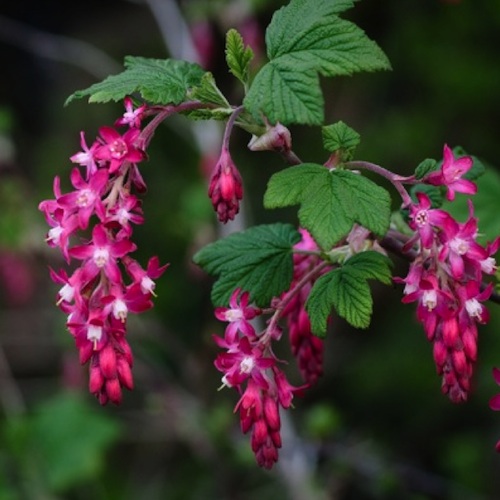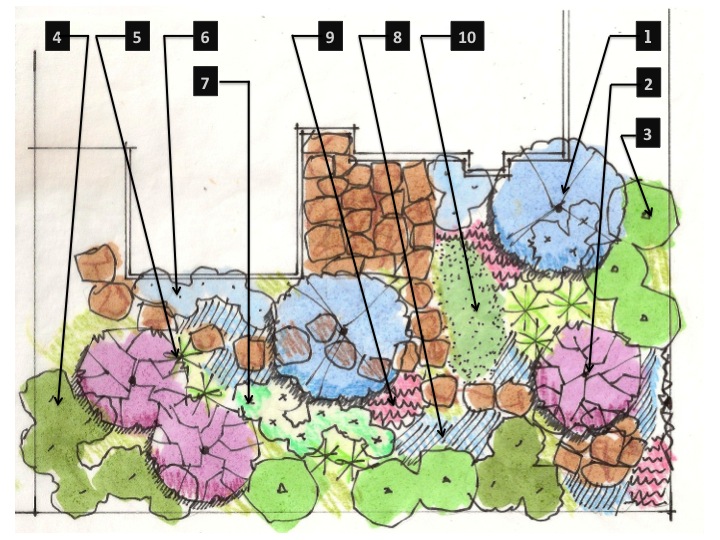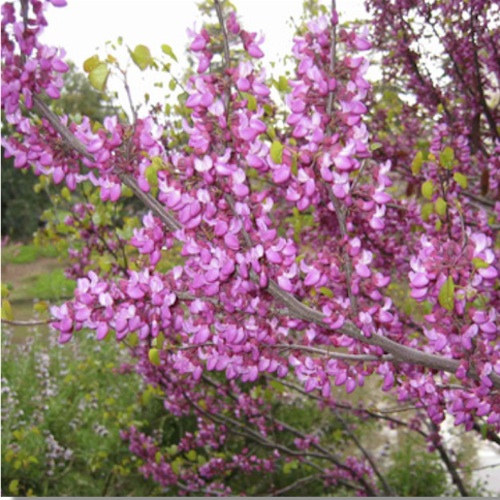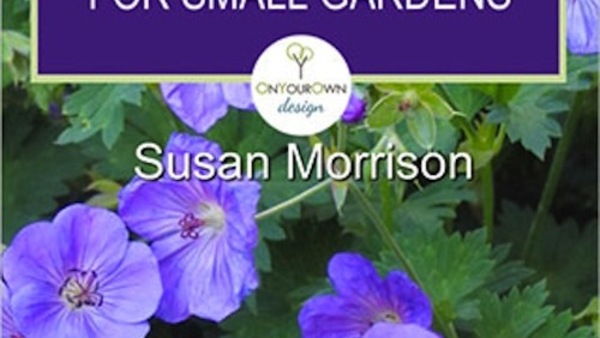
You’ve researched every plant that grows in your zone and lusted over the ones that won’t.
Now what?
One of the toughest parts of planning a garden is figuring how many of which plants to put where. Have I got a system for YOU?!
After teaching design to home gardeners for the past 20 years, I’ve developed a simple system that organizes all the plants into one of four categories. Once you’ve got that done, it’s just a matter of doing a schematic plan to figure out the overall massing of the plants.
Here’s a design I’m working on for a client, using California native plants, but this technique works with plants from any region. We’ll assume you’ve been coveting dozens of plants and through divine intervention (or checking your bank balance) you’ve narrowed your palette to your top ten, including a few from each of the following groupings.
Four Categories

Trees: I was going to define “trees” for you, but I’ve got smart readers so I’ll save us time. Use trees to provide shade, screen unpleasant views, and add visual scale.
High: These are shrubs and supported vines that grow higher than eye-level. Think of them as the skeleton of the garden. Plants from this category act as screening and backdrops for smaller plants. They reduce wind (I was going to say “break wind” but that would be embarrassing), frame views, and serve as barriers.
Medium: This category includes of shrubs, stout perennials and ornamental grasses growing between eye-level and knee-high. These plants are the muscle we add to the skeleton. Use them to fill in spaces and as star performers in your color scheme.
Low: These are subshrubs, perennials, and ground covers that stay below knee level. They’re workhorses in my designs, providing seasonal color, foreground for deep beds, slope protection, and walk-on living carpets. Meadows fall into this category and so do lawns.
Here’s the finished schematic planting plan. Refer to it as I break down my rationale for plant placement.
What Goes Where?

When it comes to placing plants in the garden, start with the trees. They’re the dominant element and usually included in the plan because they’ve got work to do. (See above). In this example, I’m using two species of trees: Mountain Lilac (Ceanothus ‘Ray Hartman’ [1]) and Western Redbud (Cercis occidentalis [2]). Each has a rounded canopy, multiple shrubby branches, and will reach a height of no more than 20-feet, perfect for this small yard. Notice the irregular balance of their placement and how they define the space while screening outward views from the house.
 |
 |
Next up are the high shrubs, Tasselbush (Garrya elliptica [3]) with its dramatic catkins, and Flowering Currant (Ribes sanguineum [4]), sporting a similar flower form and sultry ruby flowers. I’ve placed them in irregular groupings for a naturalistic effect. I’m keeping them away from the property line to prevent having to cut them back, which would destroy their natural character.
 |
 |
Medium size plants come next. The real workhorses in this garden will be bursts of Deer Grass (Muhlenbergia rigens [5]), selected for its exuberant vertical form, and Cedros Island Verbena (Verbena lilicina ‘De la Mina’ [6]), because its name sounds like the heroine in a children’s story (and because it’s as beautiful as lavender and smells like carnations!). Again, I used them in natural drifts and repeated in different parts of the composition to create continuity.
 |
 |
 |
 |
Small shrubs, perennials and ground covers complete the line-up, sweeping along and leaping across the path. Island Alum Root (Heuchera maxima [7]) adds elegance, and Beardtongue (Penstemon ‘Margarita BOP’ [8]) bursts forth in blue. For contrast, soft pink Coral Bells (Heuchera species [9]) dot the ground, and small patch of Dune Sedge (Carex praegracilis [10]) serve as a walkable lawn substitute adjacent to the patio.
 |
 |
 |
Ten varieties of plants is all it takes to make a beautiful, diverse garden. When in doubt, rather than dilute the design with too much variety, use more of the same plant in multiple locations. Pay attention to characteristics shared by a few of the plants, like flower color, the underlying form of the plant, or foliage size.
I’d love to hear whether you have a similar approach to planting your garden or if you’d like to share your approach.

















Comments
I noticed how tree placement is along the primary lines (outside walls and corners)of the house. Appreciate how well their placement relates the house to the garden.
Westerner: I see the house and the garden as one big design opportunity. In a recent article in the magazine, I showed how to expand a grid off the house and into the garden to create a cohesive composition. The same idea can be applied by paying attention to plant placement. Thanks for leaving a comment and starting the dialog.
bg
I worry about tree roots infiltrating my home's foundation. I really would like to plant an ornamental tree in my yard, but we don't have a lot of space to work with. What would be a safe distance from my house to plant a tree that has a 10-15 foot maximum height? Thanks for any help you can offer!
SweetHrt1: Your first step is to research trees that have well-behaved roots to start out. If there are parkways (aka 'hellstrips') on your area, check which trees seem the best behaved and don't disrupt paving. You can also install either a root barrier box, or panels along the side of the house to deflect the roots to a greater depth.
Your watering practices can have a big effect on root damage, as well. Most trees prefer infrequent, deep watering after the first few years, which tend to encourage the roots to go deep, instead of staying on the surface. Trees planted in irrigated lawns are the most likely to stay on the surface and reek havoc on your foundation.
My best advice is to schedule a quick visit from a certified arborist in your area. Ask about which species are the best behaved and for any other local information that would allow you to have the benefits of a beautiful, shade-giving tree without regretting it years from now.
One more caution: if you're in a high-fire area, check with your fire department for additional guidelines to keep your home safe and defensible.
I don't have an encyclopedic knowledge of all the great articles at Fine Gardening's website, but there might be more on this topic if you poke around a wee bit. I hope this helps.
Hi Billy, This is a great idea. My problem is, I like more than 10 plants! The other problem I have is my yard is sunny in one part, part shade in the middle and all shade on the far side plus my yard is terraced with retaining walls. I have had very little luck growing plants. My hostas don't even grow in the shade! I used to think I was a pretty good gardener until I moved here 14 years ago!
Billy, I love following your blog and you have a very good approach to landscape design. I like the plants that you have shown above but I live in the lower southeast and would like to know not only the hardiness zone but the newly introduced heat tolerance zone. As you have stated above "I have lusted over plants in my zone" but many will not grow in the lower south because of the heat. Maybe I'm on the wrong blog but I would like to see Fine Gardening as well as you indicate both zonal maps.
Wow, beautiful plants! I would be in heaven in this yard. In my case, I went to a bunch of garden festivals and bought the plants I loved. Now I have 65 plants in containers, (mostly 1 of each!) and am trying to figure out how to make gardens out of them! I will start with the trees.
Log in or create an account to post a comment.
Sign up Log in